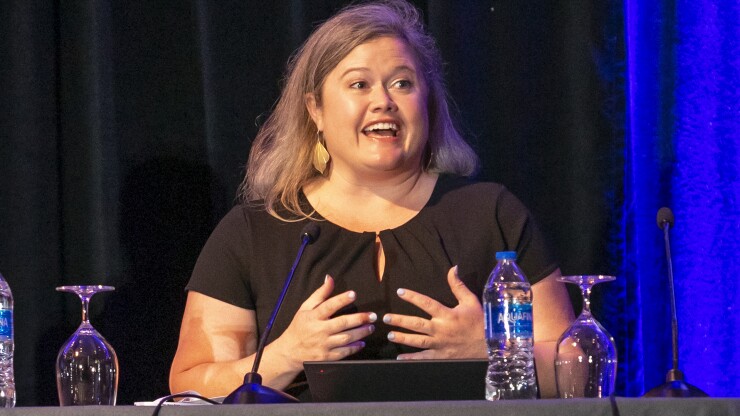Issuer community tells feds what it wants for Inflation Reduction Act’s tax credits
3 min read

The Inflation Reduction Act’s tax credits have the potential to transform the energy market, and in drafting best practices, the Department of Treasury and Internal Revenue Service should consider the compliance burdens, added premiums and easing the excessive payments statute for state and local governments.
That’s according to Emily Brock, director of the federal liaison center at the Government Finance Officers Association, speaking at a public hearing on the Inflation Reduction Act’s proposed regulations.
Many of her recommendations were outlined in a letter filed last week, cosigned by representatives from the National League of Counties and the National Association of Counties.
“Many public sector projects are financed with tax exempt and taxable bonds,” Brock said. “The same cost allocation rules should be used by a product owner for both determining what percentage of a project is financed with tax exempt debt and for calculating any reduction necessary when tax energy tax credits are utilized.”
The Inflation Reduction Act allows tax-exempt and governmental entities to receive elective or direct payments for 12 clean energy tax credits, including tax credits for electric vehicles, charging stations, as well as major investment and production tax credits.
In the event of excessive payment, a tax is imposed on the entity based on the sum of the excessive payment, plus 20%.
“We strongly recommend easing the burden of the excessive payments statute for tax exempt entities, such as a reasonable cause exception that would apply a good faith effort of the applicable entity relative to its due diligence on the front end of the project,” she added. “We encourage the IRS and Treasury to fully articulate best practices in due diligence and internal controls in good faith to avoid the penalties.”
But Brock also addressed the unique treatment of project insurance within the Inflation Reduction Act.
“Project insurance is very common in our space, and in tax equity deals,” Brock said. “But this would be the first time in the insurance market that we would address notions of elective pay and transferability and energy production facilities. In our space, we know that insurance will meet the need to insure the project. But premiums would be gauged based on the type of credit and the potential for risk or the nature of the calculus, which the insurers obviously would add into the premium.”
In addition to the concerns raised in the hearing, the letter signed by NLC, NACO and GFOA, the tax credits present complex pre-filing processes, compliance and reporting concerns and concerns over how smaller state and local governments will afford the costs.
Others provided recommendations on how the bond proceeds should be spent as well as how public power authorities will benefit from the tax credits.
“The non qualified facility should be treated first as funded by tax exempt bond proceeds. And to the extent tax exempt bond proceeds are left over, those excess tax exempt proceeds are treated as funding the qualified facility,” said Alvin Lee, partner at Novogradac’s Renewable Energy Working Group.
“Both regulations on elective payment discussed today are a sea change for a sector, with the potential to even the playing field for public power and other community owned power utilities, which collectively serve nearly 30% of the nation’s retail customers,” said John Godfrey, senior government relations director at the American Public Power Association. “This means cost savings flowing to customers, but also local ownership, local jobs, and local control.”
“To declare, we’d prefer a bang not a whisper,” Brock said. “The GFOA looks forward to working with Treasury and IRS to alleviate some of these concerns.”







